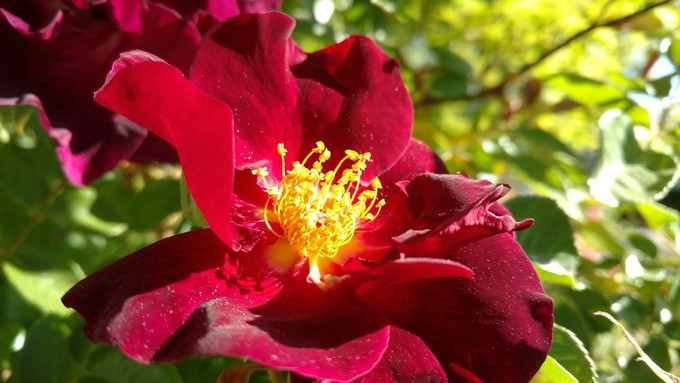
Put your roses on a regular diet with monthly feeding (plus snacks)

This Night Owl climbing rose appreciates its blanket of compost and mulch. Debbie Arrington
With rapid spring growth, my whole rose garden seems to be screaming: Feed me!
With moist soil and relatively mild weather conditions in the forecast, now is a good time to fertilize roses as they sprout new canes, lush foliage and their first wave of flowers.
But what to feed them? How do you fertilize roses in spring to support growth as well as prompt flowers?
Combine nourishment with weed control. For starters, use a combination of compost or other organic amendments and mulch.
“Apply organic soil amendments – such as (aged) horse manure, alfalfa meal, etc. – around the drip line of each of the roses,” instructs master rosarian Baldo Villegas, who grows more than 2,000 bushes in his Orangevale garden. “Some rosarians apply two inches of mushroom compost and another two inches of mulch for a total of four inches throughout whole garden bed to feed the soil, prevent weeds and preserve water moisture in the soil.”
Alfalfa meal (available at nurseries) or alfalfa pellets (available from feed stores) give roses an early burst of nitrogen – a must for new foliage. When buying alfalfa pellets, make sure it’s plain alfalfa and not amended with other ingredients such as molasses; rabbits may appreciate those extras, but they’ll just attract ants in the rose bed.
The mulch acts as a protective blanket around the bush. It speeds the decomposition of the alfalfa or manure underneath as well as smothers weeds – a big help for gardeners as well as roses. Mulch also conserves water, warms the soils, keeps roots comfortable, discourages fungal disease outbreaks and promotes healthy soil.
What mulch do roses prefer? Ground bark or dried leaves work best. Avoid rocks or gravel; they add nothing to the soil in the way of nutrients and, because they absorb heat, they can cook roots in summer. Rocks also tend to reflect heat onto the bush, further stressing the plant.
After that initial compost-mulch blanket, put your roses on a regular diet. Once a month, apply a slow-release rose food. Look for products with more phosphorus (the middle number of the three macronutrients listed on fertilizer bags) than nitrogen (the first number); phosphorus supports flowers while nitrogen prompts more leaves. Scatter fertilizer around bushes and water it in. Or use a liquid fertilizer and apply while watering. Never fertilize roses in dry soil; it can burn the foliage.
Roses can benefit from bone meal (an excellent source of phosphorus). After deadheading (removing spent blooms), scatter a few tablespoons of bone meal around the bush and work into soil. (You may need to pull the mulch away from the bush first.)
Other “snacks” to feed your roses: Fish emulsion and worm castings. Master rosarian Charlotte Owendyk of Roseville uses both. Applied while watering, nutrient-packed fish emulsion can give a weak or sluggish grower a little extra boost. Worm castings – and even better, active earthworms – help overall soil health.
Time extra fertilization to when you want the most blooms. After their first big bloom in April, roses tend to take six to eight weeks to produce another flush of flowers. If you want roses on July Fourth (for example), deadhead and feed the first week of May.
Keep up your rose feeding schedule until fall. In October, start cutting back fertilizer (or skip altogether) so your bushes will begin to ease into winter dormancy.
Comments
0 comments have been posted.Sacramento Digs Gardening to your inbox.
Sites We Like
Garden Checklist for week of May 5
Survey your garden after the May 4 rainstorm. Heavy rain and gusty winds can break the neck of large flowers such as roses. Also:
* Keep an eye on new transplants or seedlings; they could take a pounding from the rain.
* Watch out for powdery mildew. Warmth following moist conditions can cause this fungal disease to “bloom,” too. If you see a leaf that looks like it’s dusted with powdered sugar, snip it off.
* After the storm, start setting out tomato transplants, but wait on the peppers and eggplants (they want warmer nights). Pinch off any flowers on new transplants to make them concentrate on establishing roots instead of setting premature fruit.
* Trim dead flowers but not leaves from spring-flowering bulbs such as daffodils and tulips. Those leaves gather energy to create next year's flowers. Also, give the bulbs a fertilizer boost after bloom.
* Pinch chrysanthemums back to 12 inches for fall flowers. Cut old stems to the ground.
* Mulch around plants to conserve moisture and control weeds.
* From seed, plant beans, beets, cantaloupes, carrots, corn, cucumbers, melons, pumpkins, radishes and squash.
* Plant onion sets.
* In the flower garden, plant seeds for asters, cosmos, celosia, marigolds, salvia, sunflowers and zinnias. Transplant petunias, zinnias, geraniums and other summer bloomers.
* Plant perennials and dahlia tubers for summer bloom.
* Don’t wait; plant summer bulbs, such as gladiolus and tuberous begonias.
* Harvest cabbage, lettuce, peas and green onions.